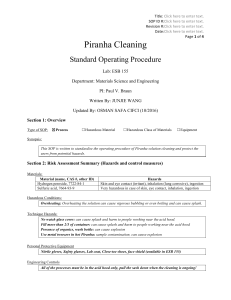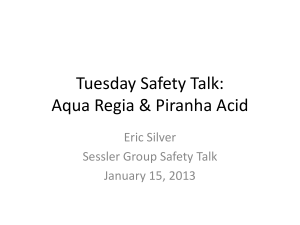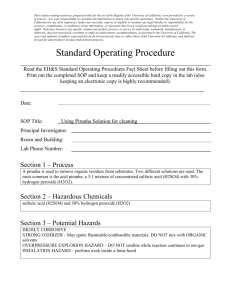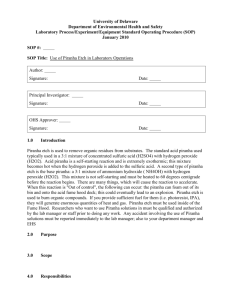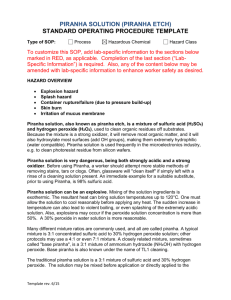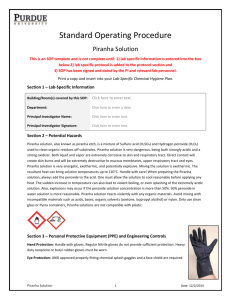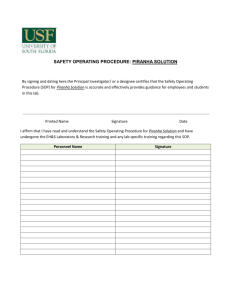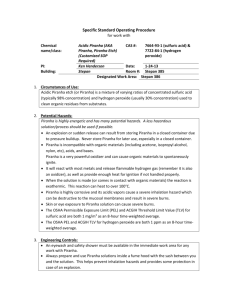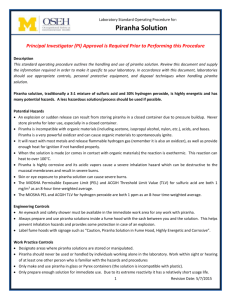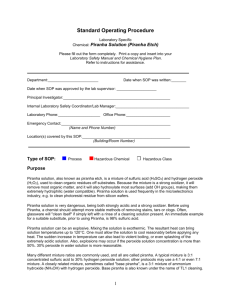Standard Operating Procedure for Piranha Solutions
advertisement
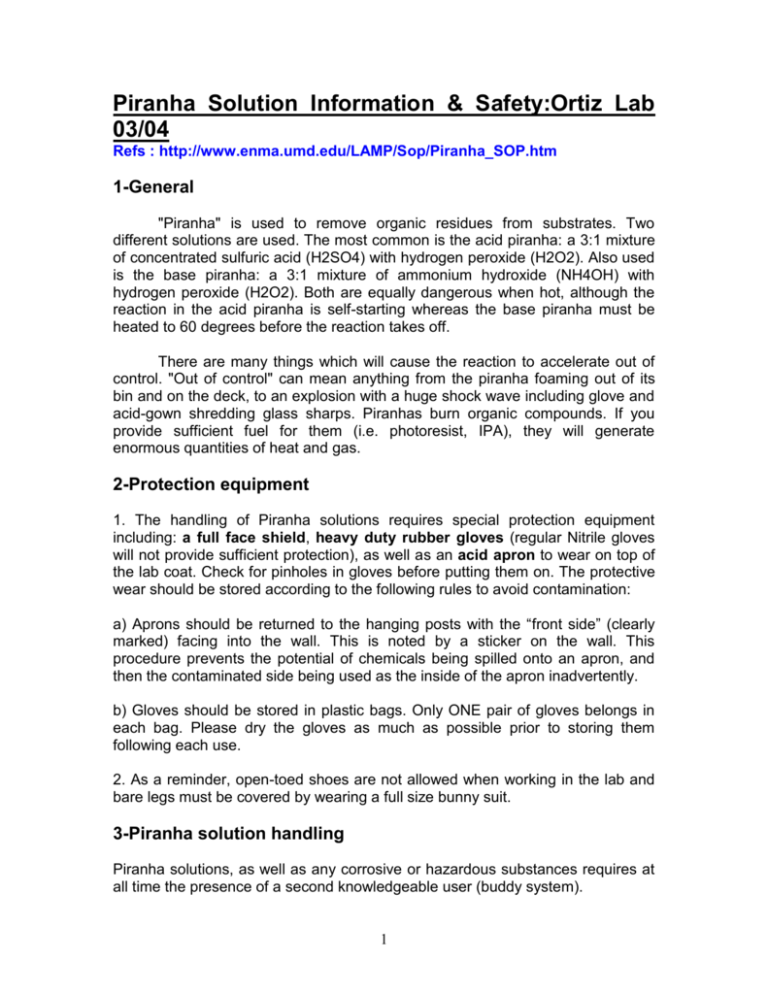
Piranha Solution Information & Safety:Ortiz Lab 03/04 Refs : http://www.enma.umd.edu/LAMP/Sop/Piranha_SOP.htm 1-General "Piranha" is used to remove organic residues from substrates. Two different solutions are used. The most common is the acid piranha: a 3:1 mixture of concentrated sulfuric acid (H2SO4) with hydrogen peroxide (H2O2). Also used is the base piranha: a 3:1 mixture of ammonium hydroxide (NH4OH) with hydrogen peroxide (H2O2). Both are equally dangerous when hot, although the reaction in the acid piranha is self-starting whereas the base piranha must be heated to 60 degrees before the reaction takes off. There are many things which will cause the reaction to accelerate out of control. "Out of control" can mean anything from the piranha foaming out of its bin and on the deck, to an explosion with a huge shock wave including glove and acid-gown shredding glass sharps. Piranhas burn organic compounds. If you provide sufficient fuel for them (i.e. photoresist, IPA), they will generate enormous quantities of heat and gas. 2-Protection equipment 1. The handling of Piranha solutions requires special protection equipment including: a full face shield, heavy duty rubber gloves (regular Nitrile gloves will not provide sufficient protection), as well as an acid apron to wear on top of the lab coat. Check for pinholes in gloves before putting them on. The protective wear should be stored according to the following rules to avoid contamination: a) Aprons should be returned to the hanging posts with the “front side” (clearly marked) facing into the wall. This is noted by a sticker on the wall. This procedure prevents the potential of chemicals being spilled onto an apron, and then the contaminated side being used as the inside of the apron inadvertently. b) Gloves should be stored in plastic bags. Only ONE pair of gloves belongs in each bag. Please dry the gloves as much as possible prior to storing them following each use. 2. As a reminder, open-toed shoes are not allowed when working in the lab and bare legs must be covered by wearing a full size bunny suit. 3-Piranha solution handling Piranha solutions, as well as any corrosive or hazardous substances requires at all time the presence of a second knowledgeable user (buddy system). 1 Whenever handling Piranha, only use glass containers (Pyrex). Piranha can melt and even attack plastic containers. Containers used during the experiment must be very clearly labeled and a warning sign, visible by any user working under the flow hood, must be posted at all time to indicate that the solutions contains Piranha mixture. Mix the solution in the flow hood with the sash between you and the solution. Wear the full protection. When preparing the piranha solution, always add the peroxide to the acid very slowly. The H2O2 is added immediately before the etching process because it immediately produces an exothermic reaction with gas (pressure) release. If the H2O2 concentration is at 50% or greater, an explosion could occur. Piranha solution is very energetic and potentially explosive. It is very likely to become hot, more than 100 degrees C. Handle with care. Picking up a beaker that is this hot will be very painful, might melt your gloves, and may cause you to spill it! Substrates should be rinsed and dried before placing them in a piranha bath. Piranhas are used to remove photoresist and acetone residue, not the compounds themselves Leave the hot piranha solution in an open container until cool. Never store hot piranha solutions. Piranha stored in a closed container will likely explode. Adding any acids or bases to piranha or spraying it with water will accelerate the reaction. Mixing hot piranha with organic compounds may cause an explosion. includes acetone, photoresist, isopropyl alcohol, and nylon. This Do not store wash bottles containing organic compounds on the piranha deck. Do not transport chemicals around the room in beakers. Never pour chemicals back into the original container. 4-Piranha waste disposal The primary hazard from storage of piranha etch waste is the potential for gas generation and over pressurization of the container when the solution is still hot. If you store a hot solution in an air tight container, it will explode! 2 Therefore prior to store the piranha solution, it must be left in an open container in order to cool down for several hours (overnight). It is your responsibility to make sure that the open container is very clearly labeled and left in a safe area for overnight cool down. Once cooled down, the solution can be transferred into a closed glass container for waste storage. The container must be very clearly labeled with the solution name and composition and must include VERY VISIBLE warning signs not to add any other types of chemicals. Collect it as hazardous waste in your satellite accumulation area. 5-Emergency procedure In case of large exposure, the victim should be removed from the contaminated area, placed under a safety shower while emergency personal is contacted (911) All contaminated clothing should be removed immediately with appropriate gloves and safely discarded. In case of contact with the skin, May cause skin burns. The affected area must be immediately rinsed with large amounts of water for at least 15 min. In case of contact with the eye, irrigate the eye for at least 30 minutes, keeping the eyelids apart and away from eyeballs during irrigation. Place ice pack on eyes until reaching emergency room. In case of inhalation, it may irritate the respiratory tract. Conscious persons should be assisted to an area with fresh, uncontaminated air. Seek medical attention in the event of respiratory irritation, cough, or tightness in the chest. Symptoms may be delayed. 6-Supply and storage 1. Do not store piranha. Mix fresh solution for each use. Excess solutions should be disposed as explained in paragraph #4. 3
